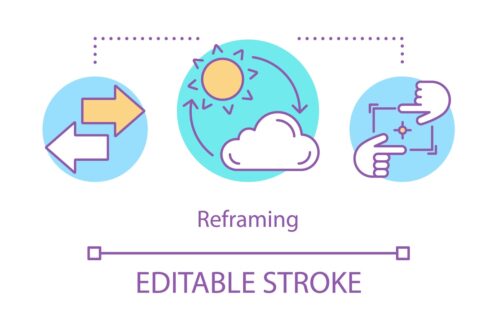Problems and challenging situations are part of life. As a result, you may allow them to shape your thinking patterns and consequently impact your overall well-being. It’s essential to understand that your thoughts, attitudes, beliefs, and frame of mind influence your emotions and behavior. This is why it’s so important to be aware and in control of your cognitions and mindset. One way of doing so is by incorporating cognitive reframing. This blog delves into the meaning and purpose of cognitive reframing, as well as steps to incorporate cognitive reframing into your life.
What is Cognitive Reframing?
Cognitive reframing, also known as cognitive restructuring, is a therapeutic technique used in cognitive-behavioral therapy to help individuals change their negative thought patterns, beliefs, and perceptions and replace them with more positive and constructive ones. However, this skill is not just for therapy – anyone can learn it and apply it to his/her life.
The Purpose of Cognitive Reframing
Cognitive reframing can help you deal with cognitive distortions – distorted thoughts, beliefs, and views of the world, others, and ourselves. It can also be a useful skill for anyone looking to improve his/her personal development and mental well-being.
The following are some of the key purposes of cognitive reframing:
- Challenge Negative Thought Patterns: Cognitive reframing helps you identify and challenge negative or irrational thought patterns that contribute to negative emotions such as anxiety, depression, or anger. By recognizing and modifying these distorted thought patterns, emotional distress is reduced.
- Perspective Change: It helps you see situations from different angles and adopt more balanced and rational viewpoints. By altering perspectives, you can often view challenges as opportunities for growth and view setbacks as temporary.
- Promote Problem-Solving: Cognitive reframing encourages you to engage in constructive problem-solving and decision-making by replacing catastrophic or self-defeating thoughts with more constructive ones. This can lead to better coping skills.
- Reduce Cognitive Biases: Cognitive reframing helps you identify and address cognitive biases, such as all-or-nothing thinking, catastrophizing, or selective attention to negative aspects of a situation. By reducing these biases, you can think more realistically and adaptively.
- Enhance Emotional Regulation: By reframing your thoughts, you change the way you interpret events and become more able to manage your emotional responses. This can lead to reduced emotional reactivity and better emotional regulation.
- Increase Self-Efficacy: By challenging negative thought patterns and adopting more positive and realistic beliefs, cognitive reframing can enhance your self-efficacy and self-confidence, which can be particularly beneficial in facing challenging situations.
- Improve Behavioral Outcomes: By modifying your thought patterns and beliefs, you can change how you react and behave, helping you make healthier choices and engage in more adaptive behaviors.
- Enhance Psychological Well-Being: Ultimately, the purpose of cognitive reframing is to improve psychological well-being and overall quality of life. It empowers you to take control of your thoughts and emotions, leading to a more positive and fulfilling life.

How to Incorporate Cognitive Reframing
As you can see, cognitive restructuring can be extremely beneficial. Here are some steps to incorporate cognitive reframing effectively:
- Identify Negative/Unhelpful Thoughts:
- Start by becoming aware of the negative or unhelpful thought patterns that you experiencing. These thoughts can be self-critical, controlling, catastrophic, or defeatist in nature.
- Challenge Negative Thoughts:
- Once you’ve identified a negative thought, challenge it. Ask yourself questions like:
- “Is this thought based on evidence or assumptions?”
- “Is there an alternative explanation or perspective?”
- “What’s the worst-case scenario, and is it as bad as I think?”
- “Is this thought based on real evidence or am I overgeneralizing, catastrophizing, thinking in black-or-white extremes, etc?”
- Once you’ve identified a negative thought, challenge it. Ask yourself questions like:
- Gather Evidence:
- Seek evidence to support or refute your unhelpful thoughts. You may find that your initial assumption is inaccurate or an exaggeration of reality.
- Reframe the Thought:
- Once you’ve challenged the negative thought and gathered evidence to refute it, replace it with a more balanced and constructive thought. Work on developing thoughts based on a more rational and realistic perspective.
- For example, if you initially thought, “I’m a failure because I made a mistake at work,” you can reframe it as “I made a mistake at work, but everyone makes mistakes, and it’s an opportunity for me to learn and improve.”
- Once you’ve challenged the negative thought and gathered evidence to refute it, replace it with a more balanced and constructive thought. Work on developing thoughts based on a more rational and realistic perspective.
- Practice Self-Compassion:
- Be kind, patient, and compassionate to yourself. Understand that changing your cognitions takes time and requires vigilance. Cognitive reframing can be challenging but it’s possible with practice. Avoid self-criticism and self-blame.
- Use Positive Affirmations:
- Use positive affirmations to reinforce new, more positive thoughts. Repeating affirmations can help change your mindset over time.
- Implement Behavioral Changes:
- In some cases, it’s not enough to change your thoughts. Start to take action to support your new perspective and frame of mind. Consider what behaviors or actions can align with your revised thoughts and incorporate habits for a healthy lifestyle.
- Monitor Your Thoughts:
- Continue monitoring your thought patterns regularly. Remain vigilant at identifying cognitive distortions and practice cognitive reframing as needed.
- Seek Professional Help:
- If you find it challenging to apply cognitive reframing techniques on your own, or if your thought patterns are overwhelming and significantly impacting your mental health, consider seeking help from a mental health professional.
Incorporating cognitive reframing can take time and practice to develop. However, it’s a powerful tool for improving mental well-being and relationship dynamics. It empowers you and helps you take an active role in managing stress, anxiety, depression, and your emotional responses. By actively working to change negative thinking and cognitive distortions, you can develop a more positive and resilient mindset.
To a Fitter Healthier You
The Fitness Wellness Mentor



